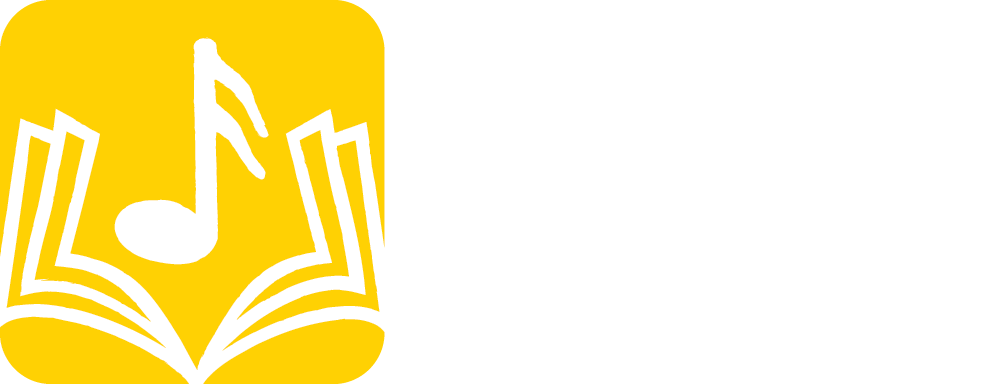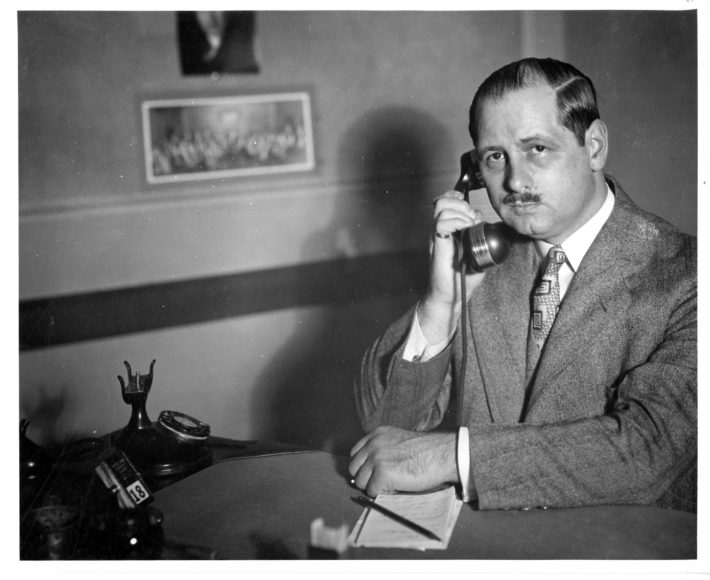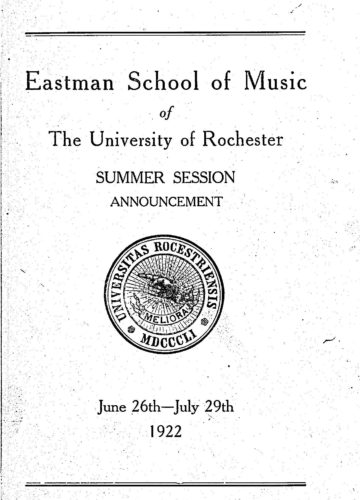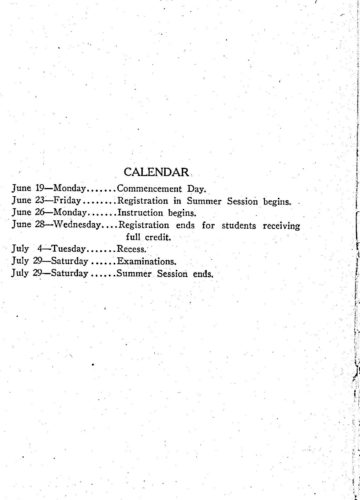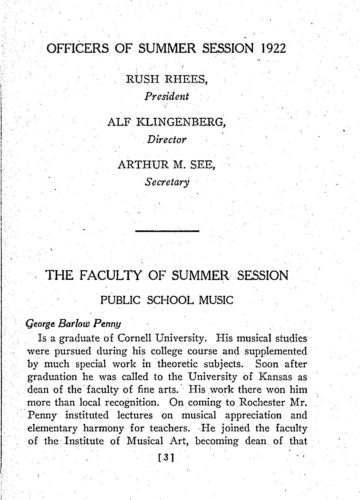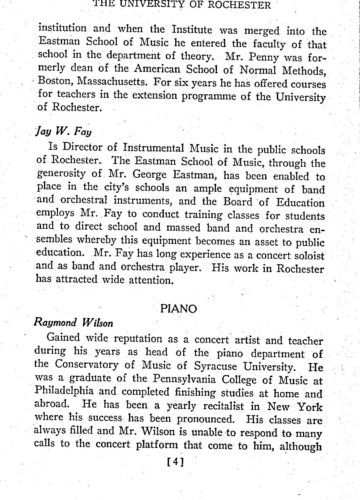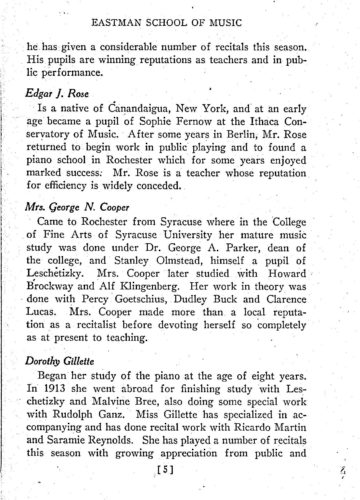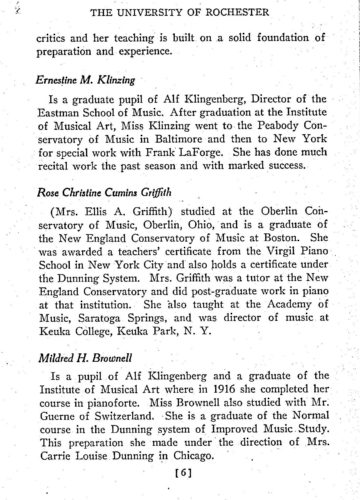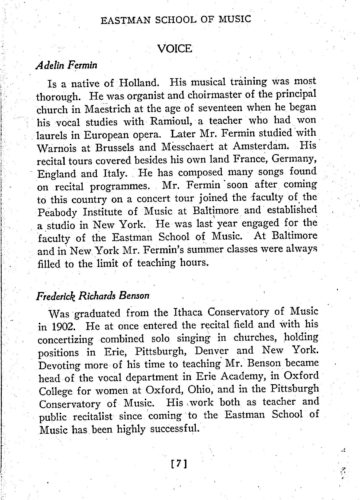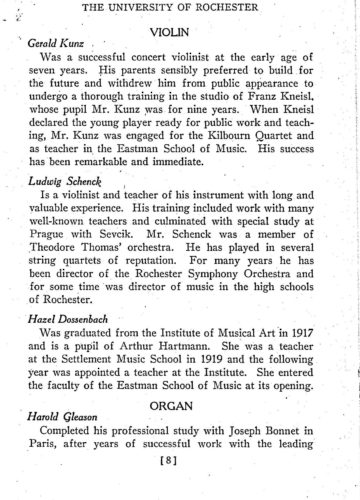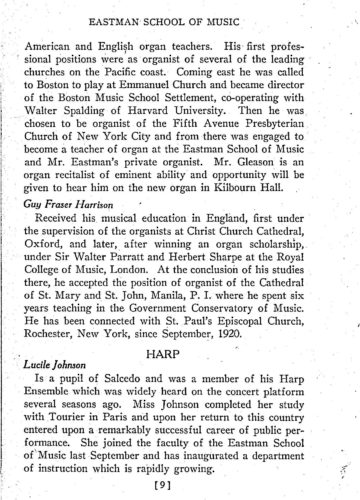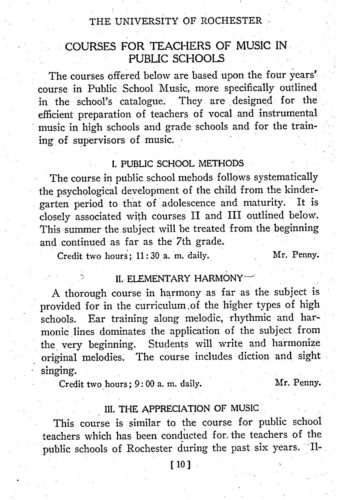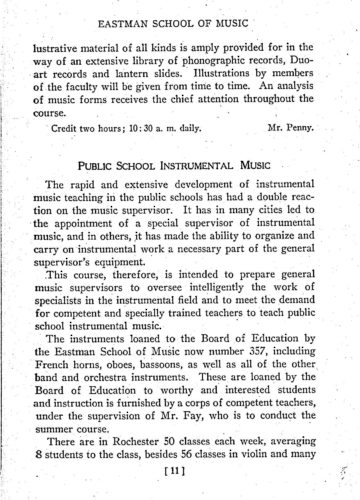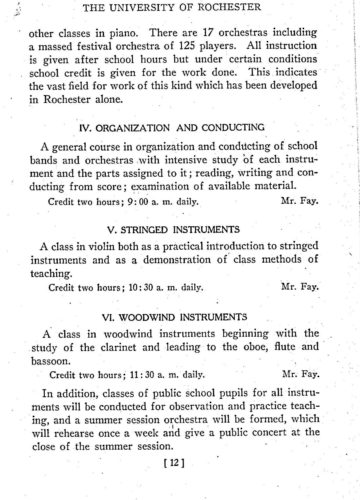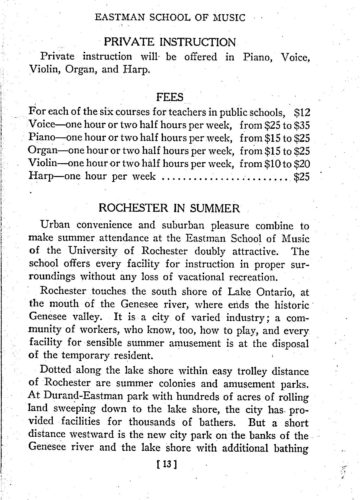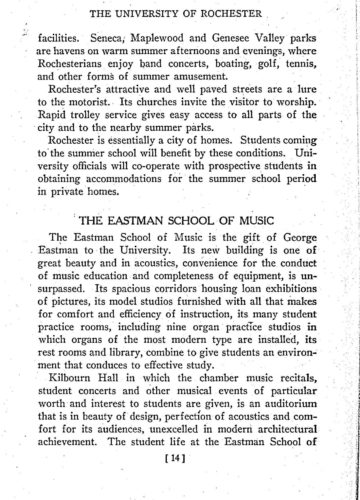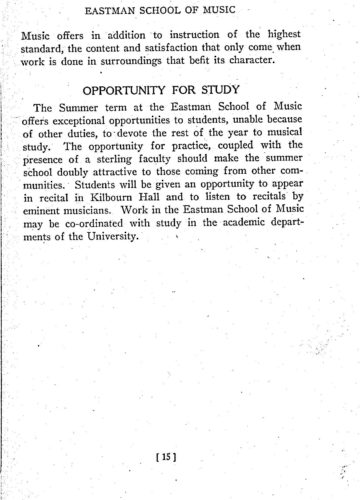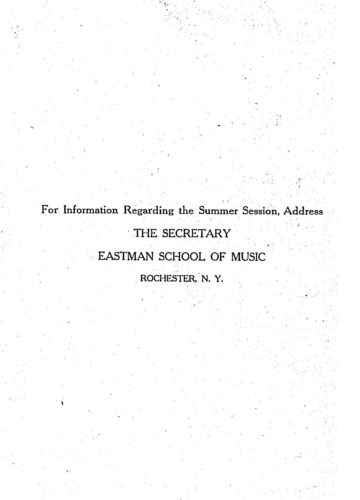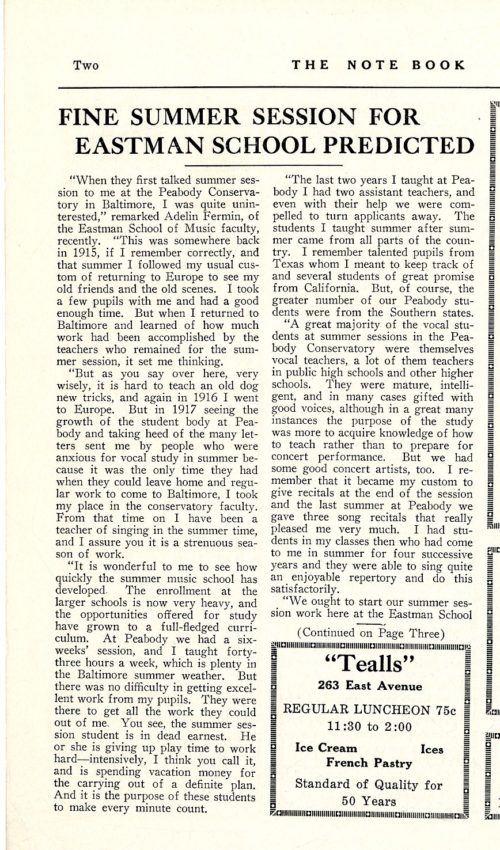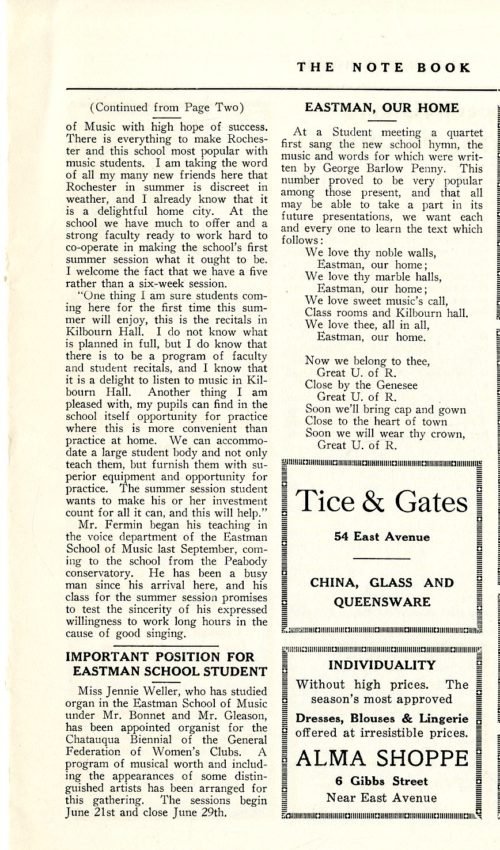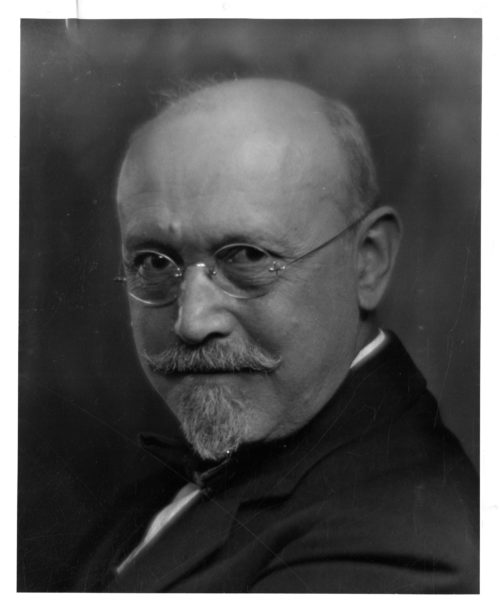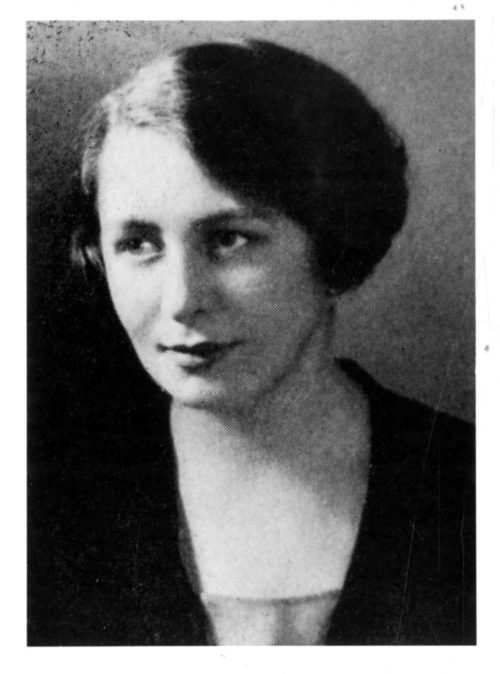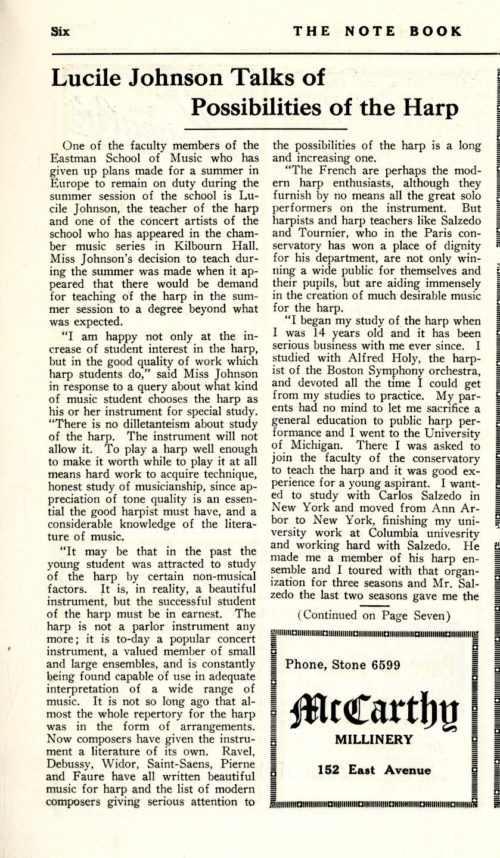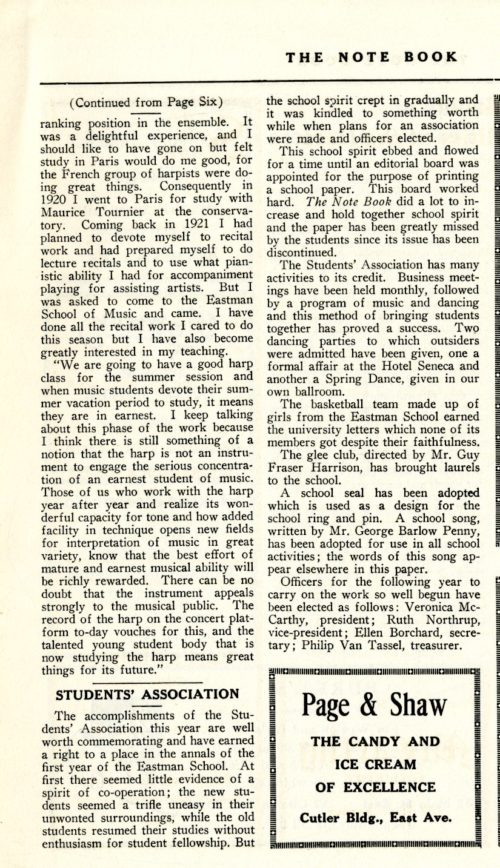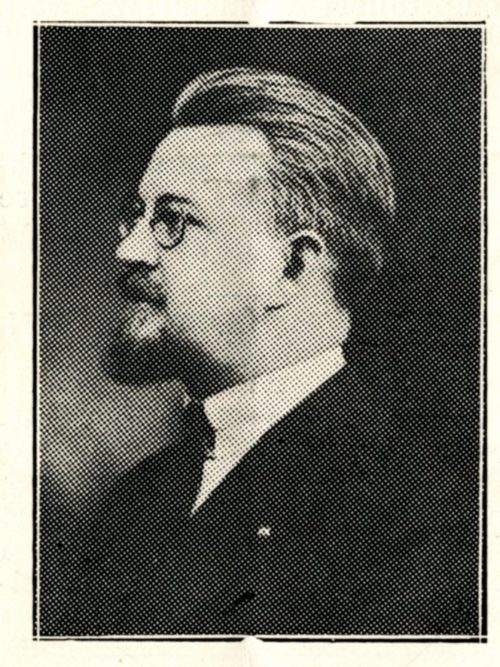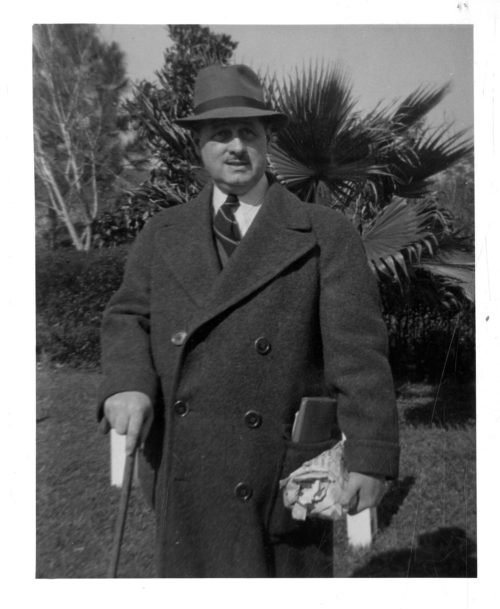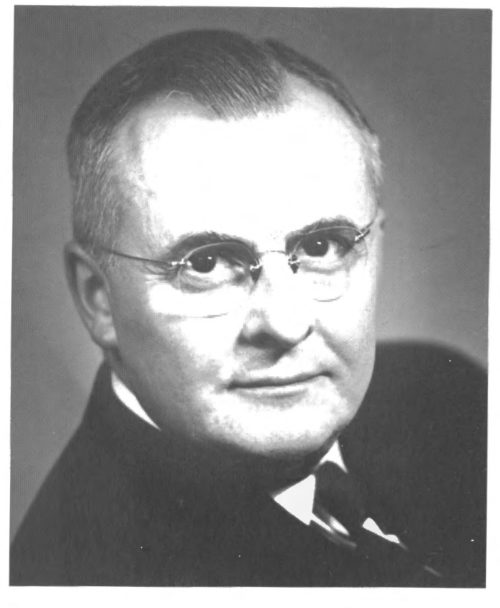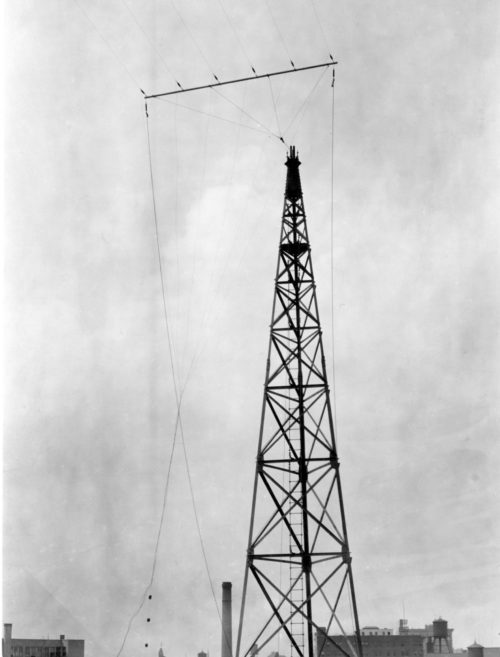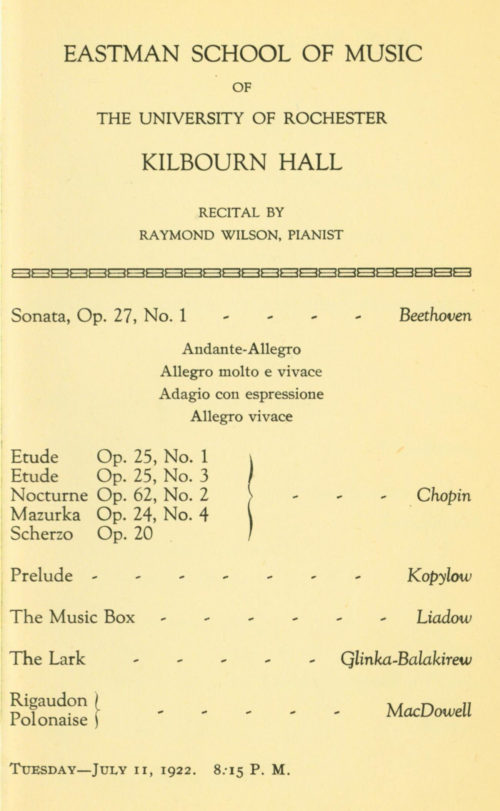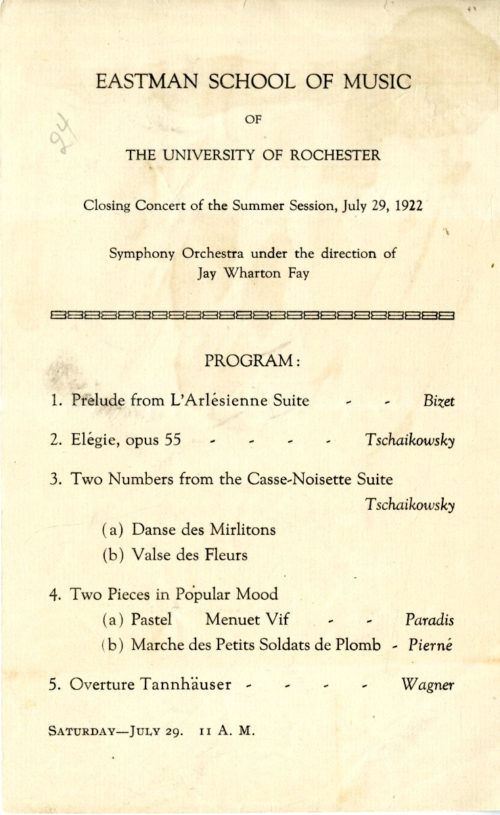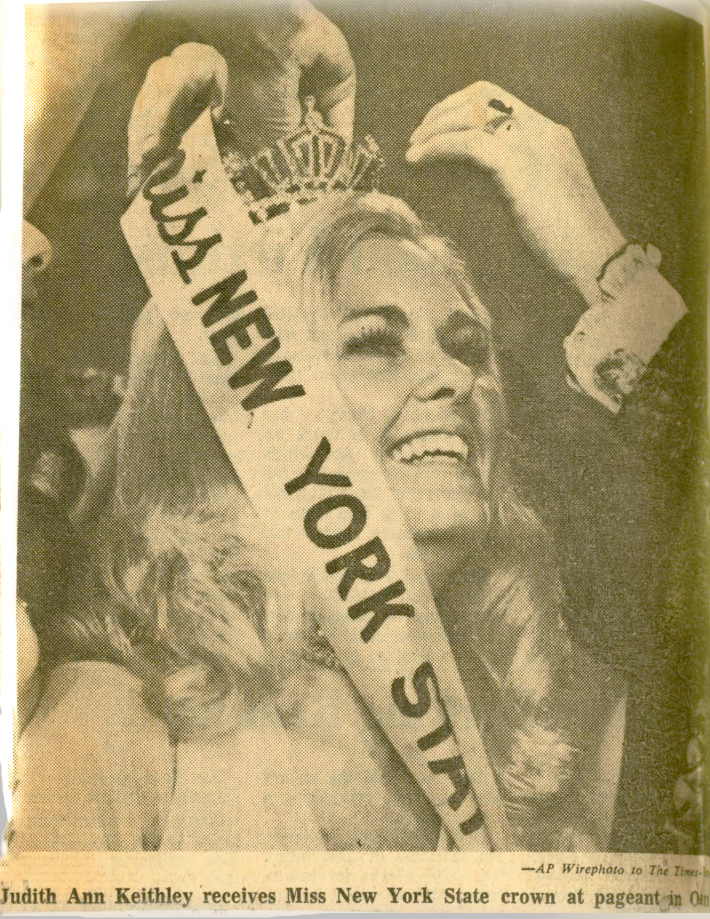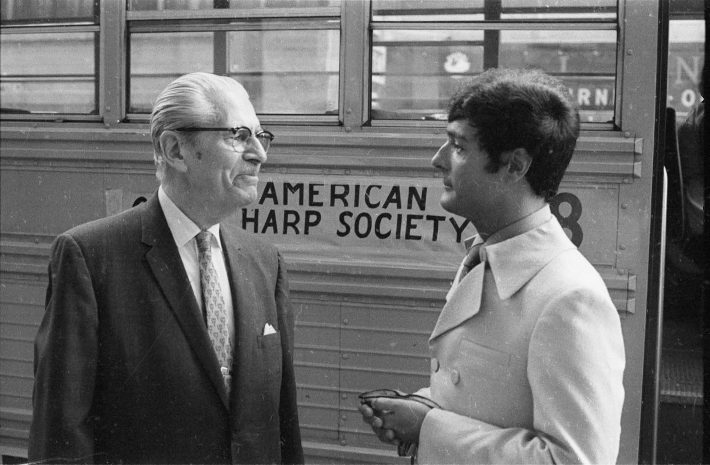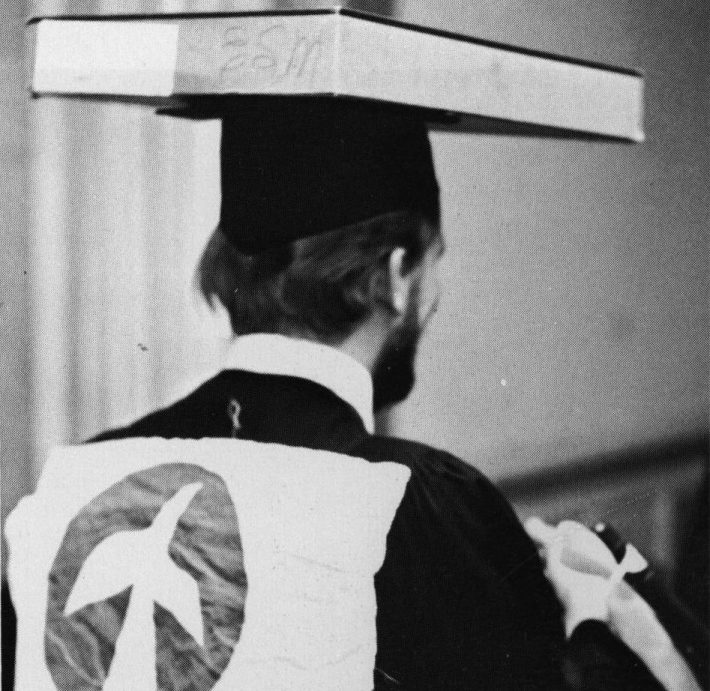Published on June 26th, 2023
1922: Opening of the Eastman School’s first Summer Session
One hundred and one years ago this week at Eastman, on the morning of Monday, June 26th, 1922, the Eastman School’s first-ever summer session opened its doors to students. One week earlier, at the University of Rochester Commencement ceremony on June 19th, the Eastman School had just graduated its first two bachelor of music degree recipients.[1] Now, on June 26th, Eastman’s first summer session was co-incident with the summer session in other departments of the University of Rochester, and would run for five weeks altogether, ending with a day of examinations on Saturday, July 29th.
Whereas the Official Bulletins for the Eastman summer session in later years would run to almost 100 pages, the Official Bulletin for 1922 took up only 15 pages of printed copy.
► Official Bulletin 1922 summer session
The Official Bulletin of the 1922 summer session is displayed here in its entirety, 15 pages altogether. (By 1945, the summer session’s Official Bulletin ran to 75 pages, reflecting a huge expansion in the curriculum, reflecting the school’s continued growth over its first two decades.) In that first summer session there were, altogether, seventeen faculty members, 15 of whom provided studio instruction in applied music (on piano, voice, violin, organ, and harp), and two of whom taught courses for teachers of music in the public schools. Eastman’s student newspaper The Note Book offered generous coverage of the summer session as it was being organized, and two of the summer faculty members were eventually covered in feature articles. Adelin Fermin, a member of the voice faculty, was quoted at length speaking of the advantages of a summer session,[2] and Lucile Johnson, teacher of harp, was quoted speaking to the many possibilities that her instrument offered. (Ms. Johnson, as was noted in print, had given up performing engagements in Europe so as to teach in the summer session.)[3] Both of those features are presented here. In addition, the Rochester press duly reported on the opening of the Eastman summer session.[4]
This feature in the student newspaper The Note Book quoted at length one of the 1922 summer faculty members, Adelin Fermin (1867-1941), commenting on the summer session and its value. Mr. Fermin served on the Eastman faculty from 1921 until his retirement in 1935.
► The Note Book June 15, 1922 page 2 and page 3 (2 .JPGs)
► ESPA 8×10 box 31-66
Lucile Johnson (1898-1992), first instructor of harp at the Eastman School and one of the 1922 summer faculty members, was quoted in this feature in the student newspaper The Note Book. Ms. Johnson (later Mrs. Lucile Johnson Rosenbloom) served on the Eastman faculty from 1921 until 1936 and was later appointed principal harpist of the Pittsburgh Symphony Orchestra.
► ESPA 4×5 box 5-84
► The Note Book June 15, 1922 page 6 and page 7 (2 .JPGs)
One noteworthy aspect of the 1922 summer session was that the six courses promoted in the curriculum were designed for those who were already teaching, rather than for the enrolled collegiate-level students. Mr. Jay Wharton Fay, supervisor of instrumental music in the Rochester public schools, had been engaged to teach three courses in public school instrumental music (organization and conducting; stringed instruments; and, woodwind instruments). Alongside his work in the Rochester public schools, Mr. Fay taught in three summer sessions at Eastman (1922, 1923, 1924), and he was active at the national level as Chairman of the Instrumental Committee of the Music Supervisors’ National Conference. In the latter capacity he wrote several features for the Music Supervisors’ Journal (today the Music Educators Journal). In the 1922 summer session, Mr. Fay used classes of school music pupils for demonstration purposes in the classroom, and he also organized those pupils into a symphony orchestra for regular rehearsals and ultimately to give a concert at the end of the session.[5]
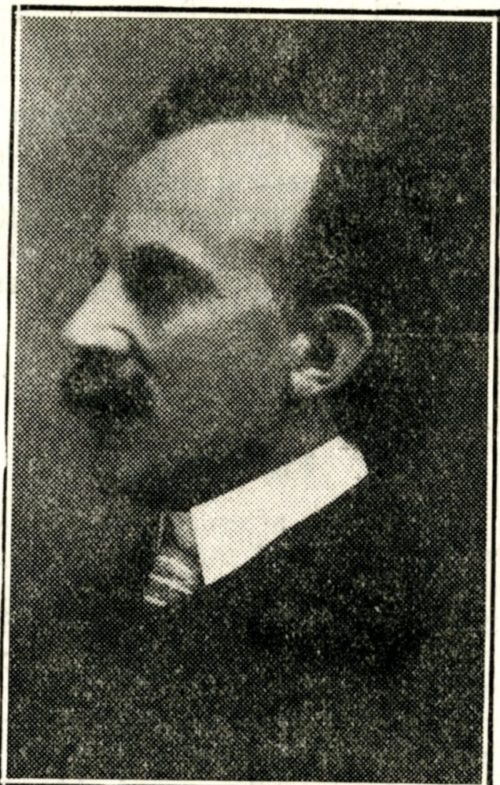
► Photo, George Barlow Penny in The Note Book, April 23, 1923
Besides Mr. Fay’s courses, there would be three courses for teachers of music in public schools (public school methods; elementary harmony; and, the appreciation of music) taught by Mr. George Barlow Penny. Mr. Penny (1861-1934) belonged to that number of Eastman School faculty members who had been instructors in the D.K.G. Institute of Musical Art before 1921. A native of Kansas, Mr. Penny’s career reflected a propensity not only for pedagogy, but for academic administration. Shortly after graduating from Cornell he had been invited to the University of Kansas where was a chief organizer and then the dean of the School of Fine Arts, in which he also taught composition, organ, and voice; he was later an organizer and the dean of the School of Fine Arts at Washburn College (Topeka, Kansas). Arriving in Rochester, New York, he served as Director of the Rochester Conservatory of Music (1910-15) which eventually was consolidated with the D.K.G. Institute of Musical Art. Besides his primary focus on music, Mr. Penny had been a lecturer on architecture, sculpture, and painting. By the time he began his Eastman School service, Mr. Penny had been listed in Who’s Who in America. Until the end of his life he was a faculty member in theory, composition, and history, and also taught music appreciation.
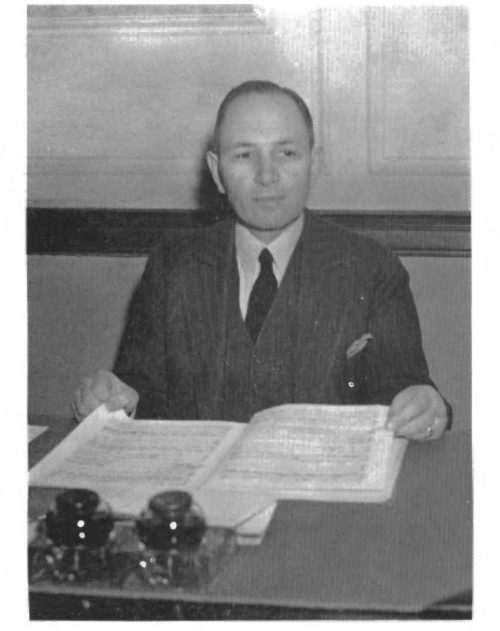
► Raymond Wilson in The Score 1940
The Director of the 1922 summer session was Mr. Arthur M. See, Secretary of the Eastman School (served in that capacity, largely comprised of financial responsibilities, from 1921 until his death in 1953). Mr. See (1889-1953) had served as secretary and had also taught piano in the Eastman School’s forerunner institution, the D.K.G. Institute Institute of Musical Art; during that time his abilities as an administrator and manager came to the fore in significant ways that would amply prove vital not only for the Eastman school but also for the outside community. For two seasons (1918-1920) he organized a chamber music series at Rochester’s exclusive Genesee Valley Club; for the following two seasons (1920-1922) he managed a concert series at Rochester’s Convention Hall, engaging such artists as Fritz Kreisler, Sergei Rachmaninoff, and Geraldine Farrar. Mr. See relinquished his concert management activity after the Eastman Theater opened in 1922. According to his obituary, it was he who conceived the idea for a civic music association; in 1929 he co-founded (together with Mr. Eastman) the Rochester Civic Music Association (forerunner of today’s Rochester Philharmonic Association), of which he would serve as executive director, as well as manager of the Rochester Philharmonic Orchestra.[6] Around the Eastman School of Music, Mr. See appears to have quickly won a reputation as a genial, resourceful, efficient, and calmly managerial professional. Students were routinely advised to “see See” about whatever issue or need, and in 1924 the student newspaper paid tribute to him noting that “. . . the students and teachers and others in the Eastman School know that duties have been assumed and done with no thought other than that of the good of our great school, that co-operation is always on tap in the secretary’s office, and that this office radiates kindness, good will and efficiency in equal measure.”[7] A wonderful acknowledgement! Mr. See would continue to serve as Director of Eastman’s summer session through 1926; in 1927 he was succeeded by Raymond Wilson, a member of the Eastman piano faculty and also the school’s Acting Director in 1923-24. Having previously been chair of the piano faculty at Syracuse University, Mr. Wilson (1888-1969) served on the Eastman faculty from 1921 until 1953. From 1953 until 1967 the summer session was directed by Professor Allen Irvine McHose, a faculty member (and sometime chairman) of the school’s music theory department. The contributions and innovations made by Professor McHose (1902-1986) to the summer session were of tremendous consequence, and he will be the focus of a later TW@E entry.
The students who enrolled in the 1922 summer session enjoyed one distinct advantage over the students who had enrolled for the previous fall semester: the Eastman School’s physical facility was finished. As Eastman School Historian Vince Lenti has described, on opening day of the 1921 fall semester, only the third and fourth floors had been finished, with the result that classes and studio instruction were conducted amidst a constant backdrop of “noise, confusion, dirt, and debris.”[8] The formal opening of the Eastman School building had finally taken place on March 3rd, 1922 in an elaborate welcome to which the general public was invited. What had yet to take place was the opening of the Eastman Theater, which would ultimately take place the following September. Nevertheless, for purposes of instruction, the school’s physical plant—encompassing spaces for administration, classroom and studio instruction, and concerts in Kilbourn Hall—was now complete.
While not inherently associated with the summer session, a particular Eastman School milestone occurred in the summer of 1922: the installation and launch of a radio transmitting service at the Eastman School. Earlier that spring, the Rochester press had reported that the two daily newspapers—the Democrat & Chronicle and the Times-Union—would jointly make a gift of a radio transmitter and associated operating equipment to the Eastman School, which would then own outright and maintain the equipment. The proposal had met with the approval of both UR President Dr. Rush Rhees and Mr. George Eastman. The plan was for the broadcast of concerts from Kilbourn Hall and, later on, from the soon-to-be completed Eastman Theater, as well as other, extra-musical programming that would include government, weather, and market reports, and also baseball scores (it’s the national game, after all!).[9] The transmitting tower, made of steel and fully 52 feet tall, was erected on the roof of the Eastman School, where it was clearly visible from East Avenue. The connected equipment was on the school’s fifth floor in a room directly below the tower. A photo of the tower was published in the Rochester press, and a similar photo is displayed here. The requisite license to operate a radio station was granted by the office of the U.S. Secretary of Commerce[10] on July 6th, 1922, and the call letters WHAM were assigned to the Eastman School’s service. On that same day the antenna was installed, with the further work of tuning and adjustments carried out more or less around the clock through the ensuing weekend. On the afternoon of Monday, July 10th, the Western Electric Co. engineer who had overseen the installation tested the set, and several telephone calls were received at the Eastman School confirming that the signal was being picked up by radio sets around town. Significantly, one listener telephoned the school from as far afield as Watertown, New York, indicating that the signal had gone further afield than merely the local vicinity.[11] The first event to be broadcast from Eastman was a piano recital by faculty member (and summer session faculty member!) Raymond Wilson on Tuesday, July 12th. Mr. Wilson’s program was duly published in the Rochester press for the benefit of those members of the public who owned radio sets and would be able to tune in.
During the summer session and beforehand, there were numerous recitals in Kilbourn Hall that June and July: mixed-bill recitals featuring students from Eastman’s collegiate division, and also those featuring students from the Preparatory Department; and several other performances besides, including the graduation recital of Roslyn Weisberg, one of Eastman’s two first recipients of the bachelor of music degree. There was also one faculty recital, given by pianist Raymond Wilson, which marked the first-ever live radio broadcast from the Eastman School, as noted above. The summer session’s closing concert (formally promoted as such) was given on the morning of Saturday, July 29th, when summer faculty member Jay W. Fay directed the orchestra that he had organized, comprised of pupils from the city’s instrumental music program. (The printed programs for both Mr. Wilson’s recital and the symphony orchestra concert are displayed here.) Altogether, while slightly briefer in duration than the summer sessions of later years and thus far comprised of a limited curriculum, the 1922 summer session might well be said to have established precedents for the coming time. The intellectual and musical caliber of the summer session administration and faculty, the splendid physical plant that was now finished, the availability and implementation of up-to-date technology, and the public showcase of performances at all levels (faculty, collegiate, community)—all of this and more was true then, and remains true today. The Eastman School’s summer session is traditionally a vibrant season of academic, professional, and extra-curricular activity offering something for everyone. Today, under the brand Summer@Eastman and directed by Dr. Sylvie Beaudette (! who is also a pianist, following in the line of the early directors See, Wilson, and McHose), the summer session offers residential music programs, day camps, online courses, and week-long institutes covering various instruments.[12] One hundred and one years along, the summer session is stronger than ever.
[1] The ceremony was held at Third Presbyterian Church downtown. From 1923 onwards, with the completed Eastman Theater available as a showpiece venue, the University’s Commencement ceremonies would be held there each year.
[2] “Fine summer session for Eastman School predicted” in The Note Book, volume I, no. 19 (June 15, 1922), pages 2 and 3.
[3] “Lucile Johnson talks of possibilities of the harp.” Ibid., pages 6 and 7. The harp has enjoyed a continuation in Eastman’s summer session, both in instruction and performance, since 1922 and into the 21st century. Professor Kathleen Bride, Eastman’s current professor of harp, has offered her popular program “The Practical Harpist” during many summer sessions. In summer of 1969, the Eastman School hosted the 6th annual conference of the American Harp Society (featured in TW@E, week beginning June 26, 2022).
[4] Indeed, ever since the groundbreaking and start of construction of the Eastman School and Eastman Theater, the Rochester press had reported in detail the developments at every juncture. Now, with the school completed and in session, news of the Eastman School was regularly reported as representing a major new locus of cultural activity in the city. An extensive sequence of press coverage is preserved in the Eastman Theater Scrapbooks and in the Rochester Scrapbooks, Sibley Music Library.
[5] “Summer session of Eastman School of Music to open to-morrow; courses for teachers of music in public schools.” Rochester Democrat & Chronicle, June 25, 1922. Preserved in Eastman Theater Scrapbook no. 1, p. 17. Sibley Music Library.
[6] “Arthur M. See, Eastman School Secretary, dies” in the Rochester Democrat & Chronicle, March 5, 1953. And, “Philharmonic pays tribute to manager” in the Rochester Democrat & Chronicle, March 6, 1953. Both items preserved in the Faculty File, Ruth T. Watanabe Special Collections.
[7] “Arthur M. See” in The Note Book, volume III, no. 10 (March 3, 1924), pages 1, 4.
[8] Vince Lenti, For the Enrichment of Community Life: George Eastman and the Founding of the Eastman School of Music (Meliora Press, 2004), page 59.
[9] “Eastman School given Democrat radio apparatus” in the Rochester Democrat & Chronicle, May 27, 1922. Preserved in Eastman Theater scrapbook no. 1, page. 17. Sibley Music Library.
[10] Serving as Secretary of Commerce at that time was Herbert Hoover, who would be elected President in 1928.
[11] “Eastman School radio set all ready for use” in the Rochester Democrat & Chronicle, July 11, 1922. Preserved in Eastman Theater Scrapbook no. 1, p. 18. Sibley Music Library.
[12] Summer@Eastman on the Eastman School of Music website, accessed on June 28, 2023.
